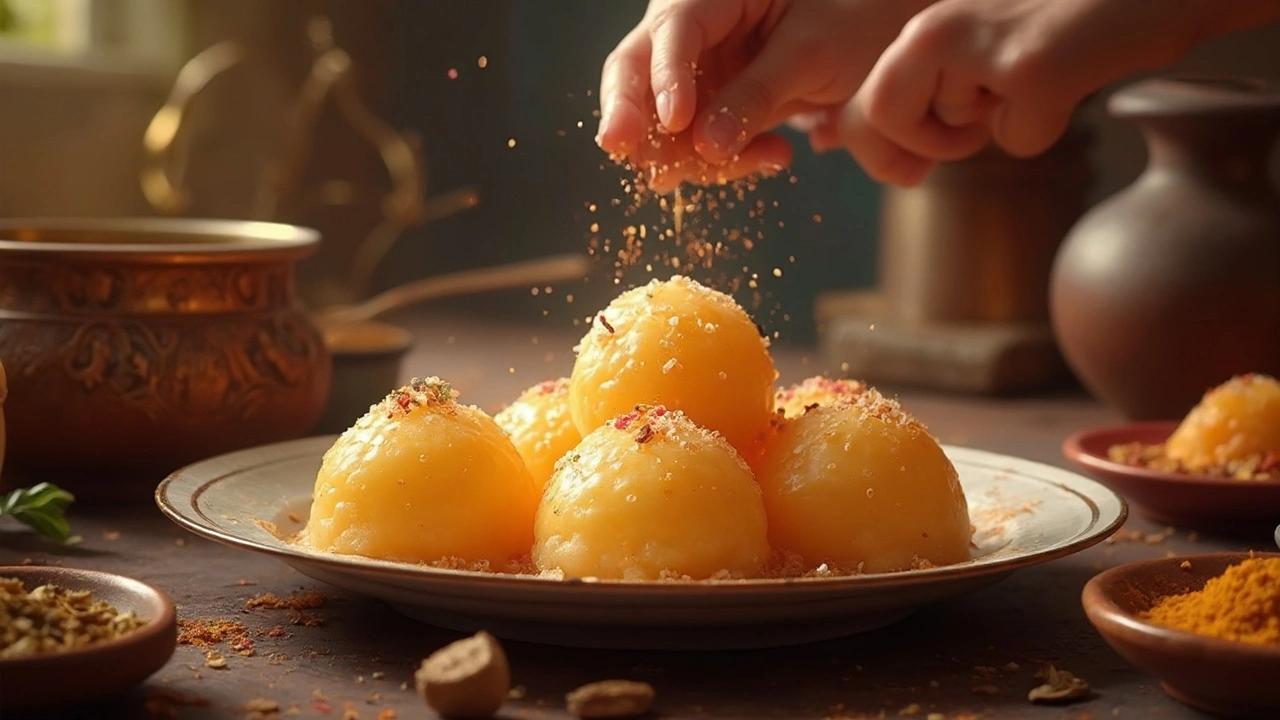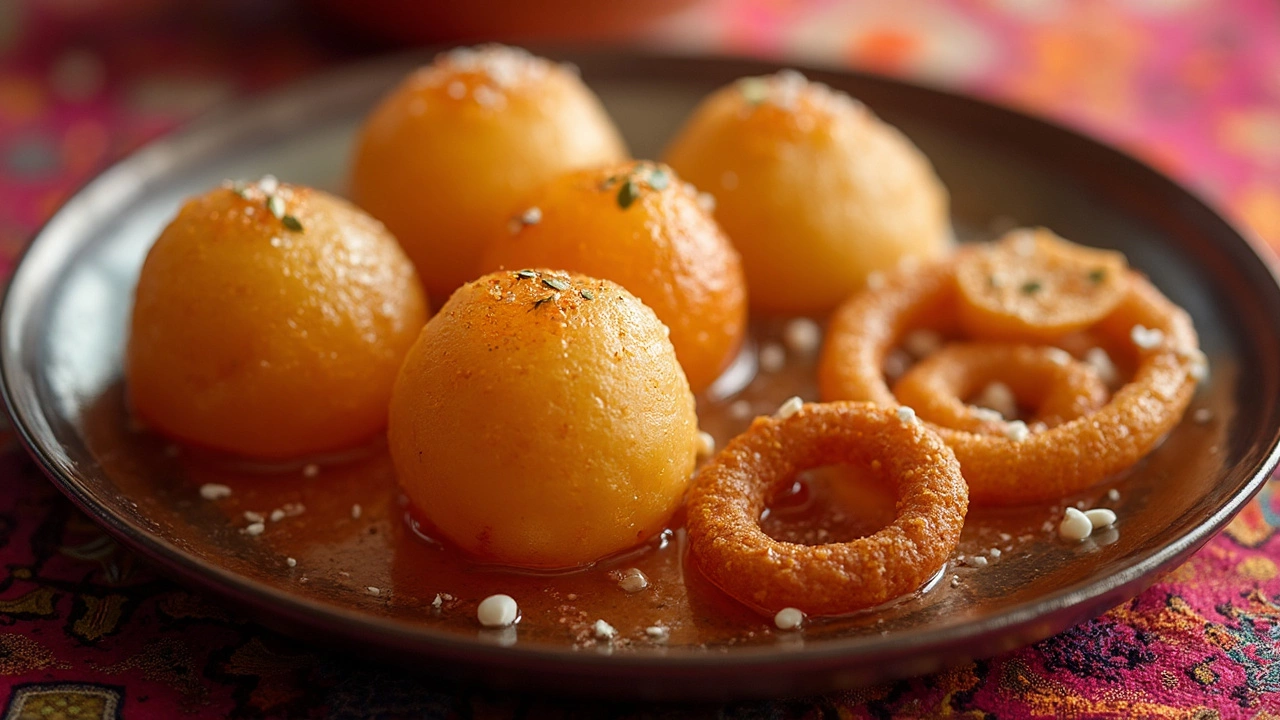Ever wondered which sweet holds the title of number one in India? Indian sweets aren't just desserts; they are a whole emotion, tied to celebrations, festivals, and everyday life. Imagine a festival without sweets – almost impossible, right? In the midst of a plethora of mouth-watering options, Gulab Jamun continues to be one of the most adored delights. These deep-fried milky doughnuts drenched in sugary syrup win hearts with their melt-in-the-mouth goodness.
Interested in trying your hand at making these treats? Before diving into the recipe, here's a little insider tip: the key to perfect Gulab Jamun is the temperature of your oil. If it's too hot, you might end up with a crispy outside and raw inside. Patience is the secret ingredient! As you venture into the world of Indian sweets, remember that it's all about balancing flavors and textures. Hang tight, because this is going to be one sweet ride!
- India's Sweet Tooth: A Little Background
- Gulab Jamun: The Beloved Classic
- Making Rasgulla: A Sweet Adventure
- Tips for Perfecting Your Indian Sweets
India's Sweet Tooth: A Little Background
India is known for its vibrant culture, and this rich background extends right into its desserts. With every region boasting its unique flavors and techniques, the diversity is absolutely mind-blowing. From the milky riches of South India's Payasam to the nutty delights of North India's Barfi, the variety seems endless.
Sweets, or 'mithai' as they are affectionately called, are not just indulgences but an integral part of Indian heritage. They mark celebrations, from weddings to festivals like Diwali and Eid. It's hard to imagine any Indian event without a plate of these sugary joys going around. According to a popular saying, 'Jo kuch miṭhã hotā hai, vo viśiṣṭ hotā hai,' which means 'What is sweet is always special.'
"In India, sweets are not simply desserts — they are treasures of emotions and memories," says Chef Sanjeev Kapoor, a renowned Indian culinary expert.
Now, despite the modern influence, the legendary Gulab Jamun and Rasgulla, along with many traditional sweets, hold their ground in households. Curious how these sweets continue to capture the nation's heart? Well, the secret lies in their timeless taste that appeals to both the young and old, creating bonds over shared plates and sweet bites.
| Sweet | Popularity Rank |
|---|---|
| Gulab Jamun | 1 |
| Rasgulla | 2 |
| Jalebi | 3 |
Such sweets are not just confections but little pieces of nostalgia, whisking people back to childhood memories. It's no wonder they're cherished across generations. So, next time you enjoy a sweet at an Indian festival or wedding, know you're participating in a truly historic and delicious tradition!
Gulab Jamun: The Beloved Classic
If you’ve ever attended an Indian wedding or festival, you’ve probably encountered Gulab Jamun, the delightful round sweet that’s kind of like a donut, but a million times better. Made from khoya, which is milk reduced to a thick paste, these little spheres are fried until golden brown and then soaked in a sugary syrup infused with cardamom and sometimes rose water.
Dating back centuries, this sweet holds a special place in the heart of Indians and has even claimed its spot at no. 1 among Indian desserts. But what really makes it stand out? It’s that perfect blend of rich flavors and soft-as-clouds texture. When you bite into it, you get that lovely gush of syrupy sweetness, with a gentle hint of cardamom waking up your taste buds.
Ready to make some? Don't worry; it’s simpler than you think. Here’s a quick rundown:
- Ingredients: Gather khoya, all-purpose flour, baking soda, milk, sugar, water, cardamom powder, and oil for frying.
- Make the Dough: Mix khoya with flour and baking soda, adding just enough milk to form a smooth dough.
- Shape and Fry: Roll small balls from the dough, ensuring there are no cracks, then fry them in medium-hot oil until they are gloriously golden.
- Sugar Syrup: While the fried balls rest, make a simple syrup with sugar, water, and cardamom powder, bringing it to a gentle boil. Add a splash of rose water if you want that floral touch.
- Combine: Soak those fried beauties in the syrup for at least an hour for maximum flavor soakage.
Quick tip: Make sure your syrup isn’t boiling hot when you add the fried balls, as it can cause them to crack. Keeping an eye on all these little details ensures your Gulab Jamun turns out just like the sweet sold at your favorite local shop.

Making Rasgulla: A Sweet Adventure
Ever tried Rasgulla? It's a sponge-like dessert that originated in Eastern India, particularly a big deal in West Bengal. You'd think making it is rocket science, but with a bit of know-how, it’s quite the opposite!
The key thing is getting the chhena or paneer just right since that's the base for this delightful sweet. You need to curdle milk, usually a couple of liters, using something like lemon juice or vinegar. Once it curdles, strain it with a muslin cloth, and don't forget to rinse it to lose that tangy taste from the acid. Squeeze it out, and you’ve got your chhena.
Now, kneading is crucial. Take your time, and work the chhena until it’s smooth and can be rolled into small balls. The smoother, the better they’ll puff up. Meanwhile, prepare a thin sugar syrup – about two cups of sugar for four cups of water – and bring it to a gentle boil.
- Shape the chhena into small balls, keeping in mind they’ll double in size when cooked.
- Add these balls into the boiling syrup and cover them. Cook on medium heat for about 15-20 minutes.
- Once done, let them cool down in the syrup. Patience is key here! They need time to soak it all in.
Getting the texture right might take a couple of tries. Remember, it’s about balancing heat and timing. Some say mastering Rasgulla is a badge of honor in Indian cooking! And hey, if you ever need an exact number, a well-made Rasgulla can absorb up to two and a half times its weight in syrup—that's impressive!
A little fun fact: October 14 is celebrated as World Rasgulla Day, marking the traditional sweet's significance in Indian culture. So, why not give it a try at home and join in the celebration? Happy cooking!
Tips for Perfecting Your Indian Sweets
Want to whip up some amazing Indian desserts that make your taste buds do a happy dance? Here are some practical tips to help you nail those beloved treats like a pro.
First things first, understand your ingredients. Ghee, which is clarified butter, is a staple that adds richness and depth. Make sure you're using fresh ghee for the best flavor. When a recipe calls for milk solids or khoya, don’t skimp on quality. These can make or break your dessert.
Temperature is another biggie. For delicacies like Gulab Jamun, ensuring your oil remains at a medium heat is crucial. If it's too hot, you'll end up with sweets that are crispy outside and raw inside. Patience is key!
Now, let’s talk about the sugar syrup, which is often used in sweets like Rasgulla. The syrup needs to be just the right consistency—neither too thin nor too thick. A good rule of thumb is the one-thread consistency. If you’re not sure, just dip a spoon into the syrup and lift it; a single thread should form as it falls.
- Always use a heavy-bottomed pan to avoid uneven heat distribution.
- Keep stirring the mixture constantly to prevent it from sticking.
- Taste as you go—balance is everything in flavor.
Feeling adventurous? Here's a quirky fact: Nearly 1.3 billion people are blessed with around 20 different types of Indian sweets to choose from annually! Quite the variety, huh?
To wrap things up, try to follow these tips, and you’re bound to impress everyone with your homemade sweet in India masterpieces. Go ahead, unleash your inner chef and sprinkle sweetness all around!
